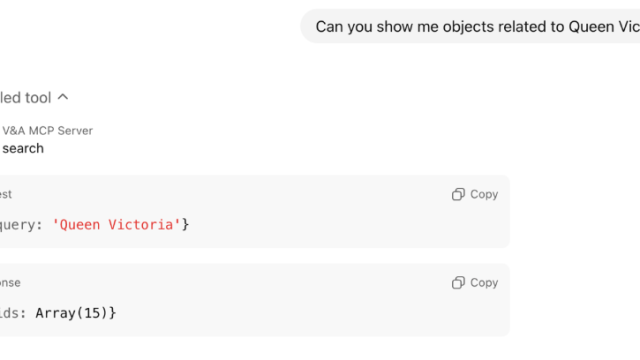This article was commissioned by the V&A to accompany the display of Gauri Gill’s series The Village on the Highway in the V&A Photography Centre 2023–24.
In Sikhism, langar is the most potent form of sevā, or voluntary community service to others: ‘a worship and homage through the act of love’ (Jacobsen 2016, p.3). Wherever there are Sikhs, there is langar. Through the long 2021 of the farmer’s protests, langar made both protest and life possible.
The first time I went to the Singhu border – the main site of the protest – I arrived well fed from home. I quickly regretted this. As soon as I made my way from the Delhi metro past the police barricades that had cordoned off one of the largest protests in the world, I was greeted by a warm voice that cut through the December chill: ‘My child, will you have tea?’
Before I could respond, a Sikh man, a sevadar, a volunteer who offers his or her services to the gurdwara free of charge, had already poured me a cup of chai. It bloomed with cardamom and the scent of fresh milk.
The chai was both a ticket into the protest site and fuel to keep going. Warmed, I joined the thousands of people who had gathered and made the border their home for the past months. It was almost lunchtime, but I learned that at Singhu, there was always some sort of langar. In my subsequent visits, I saw a snacks langar, a dried fruit langar – made possible by one wealthy, Canada-based Sikh family who had sent a truckload of almonds – and a blanket langar. Donated duvets, quilts, and heavy bed linen – urgently required as the winter set in – were distributed with no expectation of return. This, I learned, was the spirit of langar.
As a food anthropologist and participant observer, I spoke to anyone who was willing, and conversations always began with someone offering me something to eat or drink, or handing me a plate generously laden with food. In the winter months, a typical langar meal consisted of rice, rotis, a fresh, seasonal vegetable like saag, spinach laden with ghee or butter, and sometimes dessert – such as gajar halwa (a traditional North Indian sweet made by simmering grated carrots in full fat milk, sugar and ghee).
As a visitor, I was one of hundreds of outsiders (a demographic that included Instagram enthusiasts, freelance reporters and filmmakers) who had come to check out the protest. We were left astonished by the rewards bestowed on us in return for our presence. Anyone expecting to hear stories of struggle from the marginalised, were struck instead by the seeming endless generosity of free food. But the abundance of food and the proximity to the city also made it dangerously easy to experience the political space as apolitical. Nothing, not even participating in the protest, was requested in return.
However, my anthropological training reminded me that while the food I received appeared to be a gift in the true sense, gifts reproduce power structures. Who was serving, and who was eating? Who provided the material resources to keep the ‘endless’ food coming, and was it truly endless? What were the politics of langar for sevadars, and how were these politics articulated at this protest site, and whenever langar is practiced?
*
I first encountered langar when I accompanied my mother, a practicing Sikh, on her annual pilgrimage to the Golden Temple in Amritsar. It was a blisteringly hot day and my sister and I were cranky from the early morning train journey from Delhi. Despite the crowds, the lines were fairly disciplined as people entered the temple complex. After paying our respects in the inner sanctum, we walked together, arm in arm, for what my mother had promised would be our well-deserved reward – langar. The Golden Temple is the capital of langar: the communal kitchen serves approximately 100,000 people a day. Behind the scenes, hundreds of voluntary hands wash, peel, cut and prepare raw ingredients. Semi-automated machines assist in making thousands of rotis. The planet-sized vats that hold curries, dals, and mountains of rice never seem to run out. As we remarked on the scale, efficiency, and deliciousness of the food, we were met with the same response: all of this is possible because it is prepared as sevā. Sevā meant that the taste of these dishes – always vegetarian – was always appetising.
We enjoyed our langar that afternoon with hundreds of people, making the lunch gathering easily the biggest I have ever attended. Our fellow diners cut across boundaries of age, class, caste and religion. On my right, a middle-aged Hindu gentleman remarked that while he had heard about the cleanliness of the temple (the upkeep is also thanks to sevā), eating with people across caste lines was something he’d remember forever.
*
While most commonly associated with Sikhism today, langar has its roots in 12th– and 13th– century Islam. The practice of langar began with Baba Farid, a Muslim of the Chishti Sufi order. According to Sikh tradition, Guru Nanak – the first Guru – adopted the practice in the late 1400s. Guru Nanak’s father was intent on teaching his son a business lesson. He gave him twenty rupees and challenged him to figure out a way to make a profit. On the way to the market, Guru Nanak encountered a few holy men who were starving. He decided that buying food for them was a worthy investment. When he returned home, empty handed, his father chastised him. The Guru explained that by feeding the needy, he had received the highest return possible. The message of the story was clear: generosity is a form of profitability, and feeding people may be ‘free’, but it is never free of purpose. This is also what gives meaning to the Sikh motto degh tegh fateh ‘Victory to kettle and sword.’ Degh is the Punjabi word for kettle.
*
At the farmer’s protest, langar exemplified the intersection between food, service and purpose. Some of the most widely circulated images of the protests on social media showed farmers feeding the police, some of whom initially tried to shut down the resistance. This is perhaps the truest example of how the religion’s core tenets are enacted, at any cost.
While the ability to feed thousands of people can appear as a divine miracle to infrequent recipients of langar, it requires difficult, relentless labor. The sevadars who prepare and serve the food see themselves as conduits between god and the receiver. As I became interested in questions of just how such large quantities of food are prepared – and food that is fresh, abundant, and nutritious – I learned that the work for langar begins in the small hours of the morning, before the sun has come up. As many scholars have noted, the hard domestic tasks are usually performed by the least privileged Sikhs, while many wealthy members of the community choose to donate resources or money (Nippoldt 2022).
While class structures remained in place on the protest site, Navkiran Natt, a dedicated activist who lived at the protest site alerted me to how traditional gender norms were being challenged. While kitchen prep and cooking is almost always considered a woman’s job in Punjabi households, at the farmer’s protest, many men learned how to perform kitchen labour for the very first time. As I shadowed Navkiran through the site, we stopped at one tent, outside of which a group of men sat peeling a small mountain of potatoes. Navkiran joked with them in Punjabi. She told me that they were laughing about how it was only now that they had learned to ‘sort of cook’ that they understood their wives. At this site, the practice of women making chapatis, and men cooking dal and vegetables, became normalised. Langar at the site then, was not just a form of resilience for the community. It was a way in which interpersonal relationships were cast anew.
*
It has been more than a year since the farmer’s protests, and the spirit of victory that marked their closure, ended. The resistance is cited time and again as one of the most effective protests in the history of India, and langar is central to its narrative. Because farmers understood that food is indistinguishable from life, the year-long protest became not only manageable, but sustainable. To fight for the right to food, protesting farmers fed others.
I have been a fortunate recipient of many langars, including an oxygen langar during COVID, that was set up in my neighbourhood gurdwara. While the generosity and efficiency of the service is still always touching, the farmer’s protest requires us to acknowledge langar as a political act. An elderly farmer I spoke to in the winter of 2022 urged me to think of langar not as a fruit but as a seed. I continue to reflect on this, of how the act of feeding is not an endpoint, but a starting point from which new ways of life can sprout.
Further reading
Jacobsen, Knut A. 2016. ‘Sevā’ in Brill’s Encyclopedia of Hinduism, edited by Knut A. Jacobsen Helene Basu, Angelika Malinar, Vasudha Narayan
Nippoldt, L. J. (n.d.). Serving others: Individual and societal transformation through sevā in a Sikh community (dissertation)


